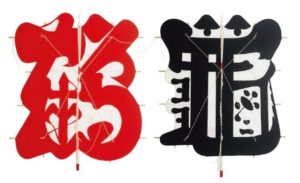Tea in Mid-December
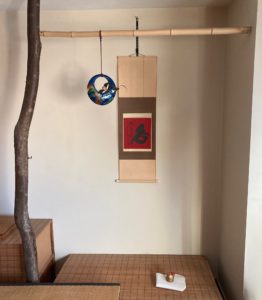
Rikyū, in Chanoyu, was a traditionalist, established traditions, and was a great experimentalist. The utensils for Tea from China were costly, beyond the reach of ordinary people. His father was a dealer of dried fish, which was of little interest to Rikyū. His life was imbued with Buddhism, which espouses poverty, and must have been devoted to the Eki-kyō, 易経, Change-sutra, as his name was Sō-eki, 宗易, Sect-change.
In my life of Tea, having had little money, improvisation has been key to getting things. As a teacher, things, utensils, are required, but one cannot or should not have ‘everything’. Yes, having a copy of a classic object can be fulfilling, but not having it should not deter one from finding a substitute. Certain Tea presentations can never actually be accomplished as the utensils are in museums and private collections. Yet, the practice of using these rarified procedures are intrinsic to a fuller understanding of Chanoyu and its history.
Apropos of this subject, the features of the tokonoma pictured above are examples of improvisation. The toko-bashira, 床柱, floor-post, is the trunk of a katsura tree that grew in front of my apartment building in the Boston area. Out of caution, it was cut down to prevent its towering height that could have damaged windows that were close by. I don’t know if there are any katsura tokobashira in Japan, but the katsura has been cherished since the Asuka period. And, it works. The bamboo crosspiece, otoshi-gake, 落とし掛け, drop-hang, is a common feature of tokonoma in Japan. Granted, the katsura trunk is wedged between the floor and the ceiling, but, like the tokobashira of traditional Japanese architecture, the tokobashira is not a supporting member of the structure.
The floor covering of the ‘tokonoma’ is a mahogany wood slat, hanging blind from a friend. Untraditional, but it and its counterparts are equal to the widths of the supporting cabinets which they cover. These three pieces help to give the impression of a separate room, a toko no ma, 床 の 間, floor ’s room.
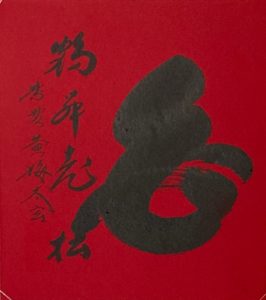
The large, bold, black figure is the Kanji, haku, shiro, 白, white. Its dense blackness is counter to the meaning of the character for white. The red paper background is complementary to the meaning of the Kanji for white, and there is the familiar phrase, kō haku, 紅白, red white.
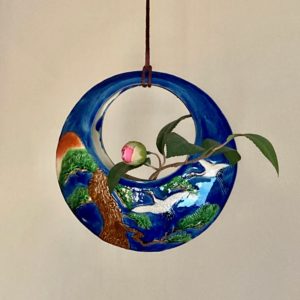
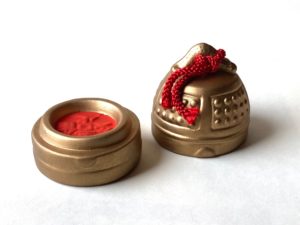
The kōgō is modeled after the bell at Dō-jō-ji, 道成寺, Way-become-temple, that is featured in theatrical dramas about a monk and a jealous beauty, who transforms into a hebi, 蛇, serpent. The red cord suggests that the piece is a bell rattle.
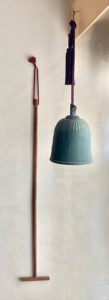
Kan-shō, 喚鐘, call-bell, patinated tetsu, 鉄, iron, hanging bell; H. 8 sun kane-jaku. Souvenir from Mi-i-dera, 三井寺, Three-well-temple, Ō-tsu-shi, 大津市, Great-bay-city. The temple is formally named On-jō-ji, 園城寺, Garden-castle-temple, which was founded in 667 as an imperial villa when Ō-tsu-kyō, 大津京, Great-bay-capital, was established near Bi-wa-ko, 琵琶湖, Strum-lute-lake. Bell striker, shu-moku, 撞木, thrust-wood, striker made of kuwa, 桑, mulberry.
The kanshō is rung to summon guests back into the Tearoom for Tea. The kanshō may be supported on a portable standing frame that can be brought to where it is be used.
On New Year’s Eve, Ō-miso-ka, お晦日, Hon.-last-day, at Buddhist temples across Japan, the main temple bell, bon-shō, 梵鐘, brahma-bell, is rung 108 times. This sacred event is called jo-ya kane, 除夜鐘, exclude-evening bell.
Hyaku-hachi, 百八, hundred-eight, refers to the hyaku-hachi bon-nō, 百八煩悩, hundred-eight anxiety-trouble; worldly desires, evil passions, greed, hatred, delusion, longing, want, etc. which result in suffering. It is interesting to note the belief that the sound of a temple bell ringing could dispel such thoughts. Ridding the mind of such distractions one may achieve Buddhist enlightenment and nirvana.
There are many explanations on the origin of the number 108. One is the numbers 10 and 8 are together, and these numbers in Japanese 10 – jū, 十, and 8 – hachi, 八, can be combined to form the Kanji, ki, moku, 木, tree, wood, which is the element symbolic of life. 108 ÷ 6 = 18. The number 6 is symbolic of Infinity in Time, and 18 is symbolic of life. 108 divided by 12 (months) equals 9, and Daruma meditated in a cave for 9 years. The number 18 is two 9s. 18 is also three 6s.
In former times when people didn’t have clocks, temples informed the neighborhood of the time by ringing their bonshō, bell. The Kanji for temple, tera and ji, 寺, is part of the Kanji for time, ji, toki, 時, which is composed of nichi, 日, sun, and ji, 寺, temple.
Time, in the past, was based almost entirely on the movement of the sun. The ‘24-hour’ period was marked with the 12 zodiac signs. Mid-night was marked with the sign of the Ne, 子, Rat, and noon was marked with the sign of the Uma, 午, Horse. The moment of sunrise was marked with the sign of the U, 卯, Hare, and sunset was marked with the sign of Tori, 酉, Rooster. There were not consistently equal time periods. Days were from U, sunrise to Tori, sunset, regardless of the season, not twelve ‘hours’. It took Buddhist temples to calculate time.

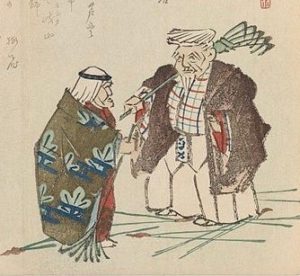
The raised feet of the two bowls are not circular: the small bowl has a five-sided foot, which is Yō, 陽, positive, and the larger bowl has a six-sided foot, which is In, 陰, negative. The pair of bowls are stacked one on top of the other in a procedure is called kasane-jawan, 重茶碗, stacked-tea-bowl, and used when serving Tea to a large number of guests in the Tearoom. The name, Shima-dai, refers to the semi-mythical ideal place where there lives a happily married couple, Uba and Jo, surrounded by auspicious motifs.
Fuji-ta Kan-dō, 藤田寛道, Wisteria-field, abbot of Un-rin-in, 雲林院, Cloud-grove-temple, a sub-temple of Dai-toku-ji, 大徳寺, Great-virtue-temple, which is located in the Murasaki-no, 紫野, Purple-field, area of Kyōto. The name of the area is called purple as it was a place where gromwell plants were grown for the purple dye that was made from its roots. It is thought that Murasaki Shiki-bu, 紫式部, Purple Rite-bureau, author of the Tale of Genji, took her name from having been born in the vicinity.
In modern times, the New Year’s tea presentations often use two chawan, one smaller than the other and placed on top of it. These are called Shima-dai Chawan, 嶋台茶碗, Island-support Tea-bowls.
For the New Year, Gen-gen-sai, 玄々斎, Mystery-mystery-abstain, XI Iemoto, Urasenke, had special bowls created by Raku Kei-yū, 慶入, Pleasure Rejoice-enter. Three bowls of graduated sizes where made and called San-tō Cha-wan, 三都茶碗, Three-capitals Tea bowls: aka-raku, 赤楽, red-pleasure, named, Nani-wa, 浪花, wave-flower, or Nani-wa, 難波, Difficult-waves, old capital became Ō-saka, 大阪, Great-slope; diam. 6 sun kane-jaku: name was chosen due to the strong current from the river that emptied into the bay. Ki-raku, 黄楽, yellow-pleasure, named, A-zuma, 吾妻, My-spouse, refers to Tō-kyō, 東京, East-capital city; diam. 5.3 sun kane-jaku. Kuro–raku, 黒楽, black-pleasure, named, Miyako, 都, Capital, named for Kyōto; diam. 4.7 sun kane-jaku. The stacked, graduated bowls were modeled after the three graduated sake cups that were the original shima-dai, 島台, island-support, used during the New Year festivities.
The bowls were changed by Yū-myō-sai, 又玅斎, Again-subtle-abstain, XII Iemoto, Urasenke. He had two bowls of graduated size made by Raku Kō-nyū, 楽弘入, Pleasure Vast-enter. These bowls were aka-raku, 赤楽, red-raku, lined in gold and silver and were named Shima-dai, 島台, Island-support, likened to the peak of Hō-rai, 蓬莱, Mugwort-goosefoot, island of the immortal sages and the Shichi Fuku Jin.
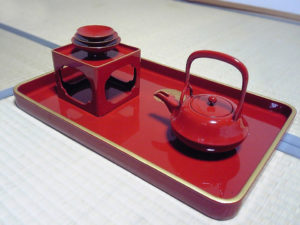
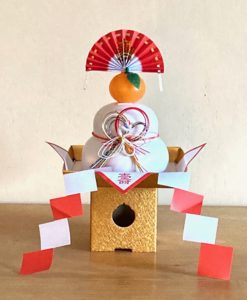
The doubled kagami mochi is a traditional display for the New Year, and the mochi is eaten at the conclusion of the celebrations. The two spheres of mochi are also symbolic of the sun and the moon, which were born of the eyes of Izanagi, and are manifestations of In and Yō.
There are many explanations of the meaning of kagami, mirror, and there is no apparent mirror. One theory is that the settled spheres of mochi are the mirror. Although they are of different sizes, as opposed to exact reflections of each other. Often, different beliefs come together and obscure the original intentions. In Taoism, the mirror is sacred, and the stacked, two sizes of mochi resemble a hyō-tan, 瓢箪, gourd-basket, which is one of the most sacred objects of Taoism. Another theory is that the two mochi rounds are for the old year and the coming year.
The citrus on the top is a daidai, 橙, bitter orange, is believed to represent the maga-tama, 勾玉, curved-jewel, and it must have an attached leaf. Although not pictured, the mochi display often has a long stick with dried persimmons attached, which is said to represent the sacred sword of Shintō, Kusa-nagi-no-tsurugi, 草薙劍, Grass-mow’s-sword. The mirror, curved jewel and sword are Japan’s imperial regalia called San-shu-no-jin-gi, 三種の神器, Three-type’s-god-container.
The origins of kagami mochi, and eating it, are present in a ceremony called kagami-biraki, 鏡開き, mirror-open. This is similar to customs of Gen-shō, 元宵, Beginning-evening, that is held on the night of the 15th day of the first month in the lunar calendar, which began 2000 years ago in China. This event is also called the Lantern Festival. On this night, dumplings made of mochi rice are eaten, and are variously named, such as Tang-yuan, 湯圓, soup-balls, which was later changed to Yuánxiāo, in Japanese, gen-shō, 元宵, first-night. The dumplings are white and some colored pink, and are often stuffed with savory or sweet foods, and put in a savory or sweet soup. Mochi is served in zen-zai, 善哉, good-exclaim, well done, which is grilled mochi in a sweetened concoction of rice and red beans, and o-zō-ni, お雑煮, hon.-miscellany-boil, soup with mochi, vegetables, fish, etc. There are a multitude of variations of these two beloved foods for the New Year.
